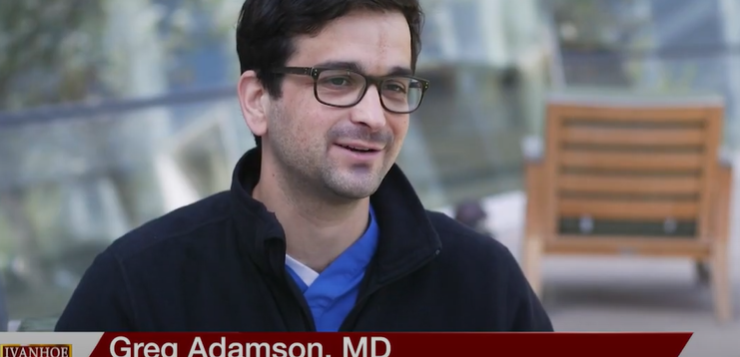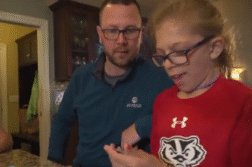Doctor Greg Adamson, MD, pediatric cardiologist at Stanford Children’s Health talks about what heart conditions Emmett Watanabe experienced when he was first born and how the doctors at Stanford Children’s Health were able to save his life.
Interview conducted by Ivanhoe Broadcast News in March 2022.
What is Tetralogy of Fallot and how rare is it?
DR ADAMSON: Tetralogy of Fallot is a heart defect that children are born with. It consists of a few different defects. There’s a large hole in the heart, and then, there’s some amount of blockage of blood flow being able to get to the lungs. Many children born with Tetralogy of Fallot have difficulty getting oxygen to their body because they don’t have enough blood flow going to their lungs.
When was it first diagnosed in Emmett?
DR ADAMSON: Emmett’s heart condition was diagnosed when he was a fetus, when he was still in his mom’s belly. It was diagnosed by his primary cardiologist, a cardiologist who works very closely with our group at Stanford Children’s Health, who found this – a severe variant of this heart defect called Tetralogy of Fallot. And his cardiologist referred him here to our Heart Center and Women’s Care Center for evaluation and management.
Can you describe Emmett’s delivery?
DR ADAMSON: Sure. So, not only was Emmett diagnosed with a heart condition, Tetralogy of Fallot, but he was also very, very small for his fetal age. So, he was estimated to only be 500 or 600 grams at the time of his diagnosis. Over the coming weeks, Emmett was not growing, and it became unsafe for him to stay as a fetus, and he needed to be born to survive. So, once Emmett was born, we found that he weighed only about 600 grams, which is about the size of a 24-ounce soda bottle. And at that point, his heart is about the size of a grape. Emmett was delivered because he was severely growth-restricted and keeping him in utero longer would have been unsafe.
I understand he was the smallest baby ever born at Stanford. Did his chances seem pretty grim at that point?
DR ADAMSON: Just to clarify, he was not by any means the smallest baby who was ever born at Stanford. Emmett had three different problems when he was born. The number one problem was that he was very, very small, weighing only about 600 grams. We have babies that are born very small, very commonly in children’s hospitals at Stanford and all around the country. The big problem with Emmett was that he had a very severe type of Tetralogy of Fallot where there was no way for blood to get from his heart to his lungs. Usually, we have the option of giving medicines to increase the amount of blood flow going to the lungs in small babies. But with Emmett’s type of heart problem, we found that there was no way to do that medically and he needed an emergent intervention to get blood flow to his lungs.
If there was no blood flow, then how could he even have survived to the point where you were able to treat him?
DR ADAMSON: He had very little blood flow going to his lungs, to the point where no number of medicines would make the amount of blood flow to his lungs adequate. So, his only option was to have an emergency intervention to increase the amount of blood flow going to his lungs.
So, after the ambulance, it basically took a village to care for him at the hospital. Can you tell me about that?
DR ADAMSON: Absolutely. So, I think the miracle of Emmett’s case was the amount of teamwork that it took to get him from being a very small, sick baby to a happy and healthy toddler like he is today. That involved the specialty of the surgeons who needed to open up Emmett’s belly to fix his major intestinal problem when he was just a day or two old; the neonatology team, which are the health care team that takes care of small babies who got him to grow from a 600 gram or 1.5-pound baby all the way up to a normal-sized child; and then the cardiology team who worked to put a stent in his heart to open up the amount of blood flow to his lungs. It really took a village to get Emmett where he is today.
Were his intestines twisted?
DR ADAMSON: Yeah. When Emmett was two days old, all of us were struggling with coming up with a plan to get more blood flow to his lungs emergently. Around that time, we discovered that his intestines had twisted on themselves and cut off their blood supply. So, at the moment where he needed a heart intervention emergently, he also needed an abdominal surgery emergently. So, the general surgeons took Emmett down to the operating room and did a very high-risk surgery to fix the twisted blood supply to his intestines. At that time, again, Emmett was only about 1.5 pounds.
Was there a chance that he might make it?
DR ADAMSON: Yeah. The constellation of Emmett’s problems – being born very small, having a major intestinal problem, and having a major heart problem where he was very blue – altogether, made his chances of survival very low. It was the teamwork effort of multiple providers working together to fix each of these problems that allowed him to grow and become what is now a happy and healthy toddler.
Had you ever put a stent in a baby so small?
DR ADAMSON: So, when babies are born with blockages of blood flow getting from their heart to their lungs, sometimes the only safe option is to put a stent in that narrowing to open it up. This is a procedure that we perform very commonly, but we had never performed this procedure in a baby as small as Emmett.
How did the procedure go?
DR ADAMSON: The procedure at the beginning, we all decided that the only chance for Emmett realistically to survive would be to put in this stent in the cardiology cath lab. He was very sick during the procedure and his blood oxygen levels were very low, but ultimately, the procedure went smoothly.
Did it seem like, at one point, this family couldn’t catch a break?
DR ADAMSON: Yeah. All of us were very impressed with the strength that Emmett showed himself, fighting through all these challenging problems, and really the grace that his mother, Yatin, and his father, Derrick, showed, helping Emmett through all these really challenging problems. And it did seem, as time went on, more and more problems kept popping up. But by working together with all the teams here at our hospital and with Emmett and his family, we were able to work together to get him through all these challenges.
So, then he was born premature. You have that issue. Then you had the blood flow issue. You took care of that with the stent. Then his intestines were twisted. That was taken care of. That still didn’t take care of, but then you still had to go in at four months old to have open heart surgery?
DR ADAMSON: That’s correct. So, the initial procedure to put in a stent to open blood flow to Emmett’s lungs, the goal of that was to give him time to grow so that he could undergo complete repair of his heart defect at a larger size where it would be safe to proceed. So, once Emmett got to be about four months old, he weighed over 6.5 or seven pounds. And at that point, our cardiac surgical team was able to take him for a much more straightforward repair of his heart defects.
What did they do?
DR ADAMSON: So, the surgical repair of Tetralogy of Fallot involves opening up a child’s chest and doing open heart surgery. The surgeons put a patch to close a big hole in Emmett’s heart, and then they put in a new valve to create a connection from his heart to his lungs that’s more sustainable.
At what point did you realize Emmett was going to be OK?
DR ADAMSON: The initial interventions, which were fixing his intestines and stomach and then second, giving him a way for blood flow to get to his lungs, those were temporizing measures. After that, Emmett still had a big uphill climb. He was only a pound and a half and needed to spend months growing and getting through all the different problems that are going to occur for small babies in an intensive care unit. Once Emmett was about two months old and had gotten through a lot of the issues that can occur in prematurity, we all felt very confident that he was going to make it. Once Emmett was two months old and had gotten past many of the issues that come with prematurity, all of us felt very confident that he was going to make it.
How long was he in the hospital?
DR ADAMSON: Overall, Emmett was in the hospital for about six months. The first week was the scary part of his life, where he needed two major interventions to have a chance at survival. After that, it was a long intensive care unit stay where he was learning how to eat and grow and breathe on his own. And he needed interval procedures to increase the blood flow to his lungs during that time. Once he was four months of age, he underwent the open-heart procedure to fix his heart defect. He needed about two months of recovery from all of that, and then he was ready to go home.
Do you see very many patients with this condition or is his condition just more severe than others?
DR ADAMSON: I think, in isolation, any one of Emmett’s conditions are things that we commonly treat in our hospital. We commonly see babies who are born premature. We commonly see babies with Tetralogy of Fallot and we commonly see babies who have their intestines twisted. The fact that all three of these things were happening at the same time in a very severe form made Emmett’s treatment plan very challenging.
How is Emmett today?
DR ADAMSON: Today, Emmett is a healthy, happy toddler. He got through his whole hospitalization without having any major problems to any of his ability to live and laugh like a normal baby. To the best of our knowledge, he’s going to have a full and healthy life.
In your opinion, how big of a miracle is Emmett?
DR ADAMSON: Emmett had a very uphill battle. And the fact that he got to where he is today was the result of a lot of hard work by many different people at our hospital who were able to bring him from, you know, a very sick, very small baby into a happy and healthy toddler.
Is Emmett a fighter?
DR ADAMSON: Absolutely. I would absolutely say that Emmett is a huge fighter. There were many times during the first couple of weeks of his life where he was extremely ill, and it seemed unlikely that he was going to survive. But every step of the way, he’s exceeded our expectations and fought his way through this.
END OF INTERVIEW
This information is intended for additional research purposes only. It is not to be used as a prescription or advice from Ivanhoe Broadcast News, Inc. or any medical professional interviewed. Ivanhoe Broadcast News, Inc. assumes no responsibility for the depth or accuracy of physician statements. Procedures or medicines apply to different people and medical factors; always consult your physician on medical matters.
If you would like more information, please contact:
Elizabeth Valente-Pigato
evalentepigato@stanfordchildrens.org
Sign up for a free weekly e-mail on Medical Breakthroughs called First to Know by clicking here




